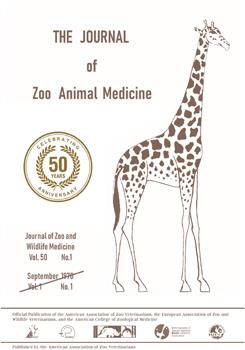Green turtles (Chelonia mydas) are unique because hatchlings and pelagic juveniles are carnivorous, whereas later life stages become primarily herbivorous. Although this dietary shift is well understood, nutritional requirements at each developmental stage are not. Diet selection during rehabilitation is challenging, because turtles are often fed high-protein, low-fiber diets to counteract poor appetite and emaciation, which can result in gastrointestinal disorders. The objective of this study was to analyze hematology, plasma biochemistry, and nutritional analytes to determine the effect of diet on rehabilitating green turtle health and recovery. Turtles in rehabilitation at the Georgia Sea Turtle Center (GSTC) on Jekyll Island, Georgia (n = 21) were sampled at admission, mid-rehabilitation, and recovery. Duration of rehabilitation ranged from 48 to 233 days (mean = 117) and included a shift from a mixed seafood–vegetable diet at admission to a primarily herbivorous diet at recovery. For comparison, free-ranging turtles captured during an ongoing monitoring project in St. Lucie County, Florida (n = 34) were evaluated for the same variables. Several analytes improved during rehabilitation, including total protein, uric acid, potassium, and vitamins A and E. Others were significantly different, including higher cholesterol and triglycerides, but lower calcium, vitamin D, and magnesium in recovery compared with freeranging turtles. These variations illustrate the benefits of appropriate supportive care during rehabilitation as well as the importance of a species-specific diet for green turtles, and may facilitate formulation of nutritionally complete gel diets for this species under human care.
How to translate text using browser tools
5 April 2019
COMPARISON OF HEMATOLOGICAL, PLASMA BIOCHEMICAL, AND NUTRITIONAL ANALYTES OF REHABILITATING AND APPARENTLY HEALTHY FREE-RANGING ATLANTIC GREEN TURTLES (CHELONIA MYDAS)
Jennifer C.G. Bloodgood,
Terry M. Norton,
Lisa A. Hoopes,
Nicole I. Stacy,
Sonia M. Hernandez
ACCESS THE FULL ARTICLE
Chelonia mydas
diet
green turtle
plasma biochemistry
trace minerals
vitamins





